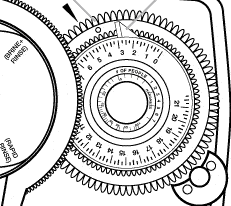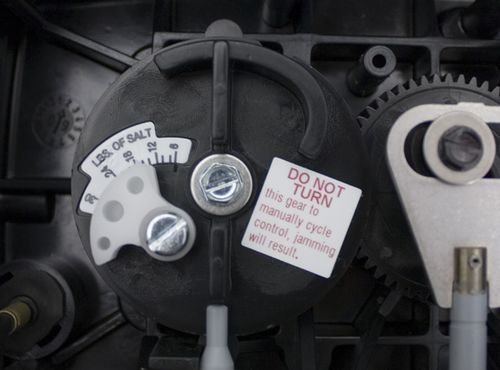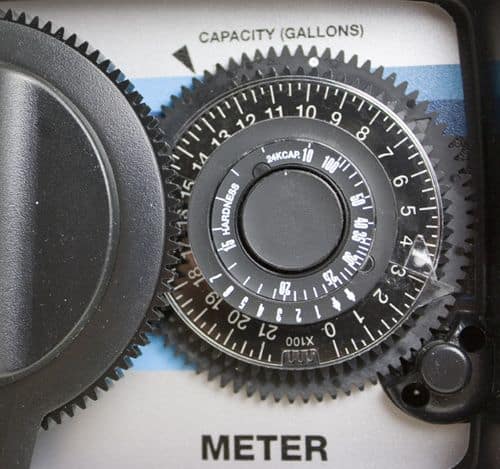The resin bed in residential water softeners has to be periodically “recharged” with a powerful brine solution in order to “regenerate” themselves.
This recharge is started and controlled by a control valve located on top of the softener.
There are two different control mechanisms for residential water softeners.
A clock timer, often known as a day clock, is the oldest and most basic.
It functions similarly to a stove’s timer.
You pre-select a day for regeneration, and on that day, the timer starts and completes the softener’s regeneration.
Every sixth day can be a normal setting.
No matter how much water was used in the house, the softener would renew every sixth day.
When a certain number of gallons of water have been handled, a metered softener starts the regeneration process.
It does this by counting the gallons of water that flow through the softening.
Regenerations happen less often when less water is consumed, and vice versa.
Metered softeners are often thought to be more cost-effective and environmentally friendly than timer types.
Most of the time, this is probably accurate.
However, metered systems don’t always save water.
Both timers and meters must be set up correctly, and a meter that is improperly programmed is just as ineffective as one that is improperly set.
It is necessary to make certain assumptions (guesses) while programming a water softener.
The most fundamental is that a resident of a home requires 75 gallons of water daily.
A person needs 75 gallons of household water each day, according to the basic estimate made by certain manufacturers who try to be more scientific by adjusting the number up or down.
Typically, the figure works very well.
Knowing the water’s hardness is also essential for setting up the softener properly.
The amount of calcium and magnesium in the water is measured as hardness.
It may be represented in grains per gallon or parts per million, which is more typical.
There are 17.1 parts per million in a “grain.” The amount of iron and manganese in the water must also be known.
While they are seldom in municipal water sources, iron and manganese are typically problems with well water.
This debate takes the stance that there is no iron or manganese in the water in order to keep things simple.
Another set of problems arises when iron and/or manganese are present.
Setting the softener control without knowing the water’s hardness is meaningless, similar to setting your watch without knowing the time.
Fortunately, tests for determining hardness are simple and affordable, and they may be found at hardware shops, pet stores, pool stores, and many other places.
If you reside in a city, you may also just phone the local water department and ask them.
They could provide you with the milligrams per liter hardness level.
Divide the milligrams per liter by 17.1 to convert to grains per gallon, which is the unit used in water treatment terminology.
A grain of hardness is equivalent to 17.1 mL or 17.1 ppm, or 17.1 milligrams per liter.
You can configure the softener after you know the water’s hardness and how many people reside in your house (if you can’t recall, ask a family member).

What You Are Attempting To Accomplish
A. Calculate the volume of water that your water softener can soften before it has to be recharged, and
B. Provide the softener with the knowledge it needs to partially recharge itself before it reaches its capacity.
How To Calculate The Gallon Capacity
The theoretical capacity, or “size,” of your softener is given in grains.
For instance, a “40,000 grain softener” should theoretically be able to handle 40,000 grains of hardness in between regenerations.
Your softener will treat 40,000 grains divided by 20, or 2,000 gallons of water, between regenerations if your water contains 20 grains of hardness per gallon.
A softener regenerates around every fourth day if your household consumes 500 gallons of water each day.
Divide 2,000 by 500.
The aforementioned scenario is just hypothetical since a softener that has been recharged has a lower capacity than it originally claimed and because the amount of salt needed to recharge it determines its actual capacity.
The capacity increases with salt content.
The 40,000 gallon estimate assumes you give the softener the highest salt dosage possible, which is an impractically large quantity.
The maximum practicable salt dose is 15 lbs.
per cubic foot of softener resin, and even then, it will only renew a 40,000 grain softener to a capacity of roughly 37,500 grains.
The information necessary to tune the control valve for optimum performance is provided for the most popular sizes of home water softeners.
You’ll see that the softener’s treatment capacity reduces as less salt is needed for regeneration, but its salt-use efficiency increases more quickly.
| Common Size Designation in Grains | Mineral Tank Size | Cubic Feet of Resin in the Mineral Tank | Actual softening capacity if dosed with 6 lbs salt per cubic foot of resin | Actual softening capacity if dosed with 10 lbs salt per cubic foot of resin | Actual softening capacity if dosed with 15 lbs salt per cubic foot of resin |
| 15,000 | 7″ X 44″ | 0.5 | 10,000 | 12,500 | 15,000 |
| 24,000 | 8″ X 44″ | 0.75 | 15,000 | 18,750 | 22,500 |
| 32,000 | 9″ X 48″ | 1.0 | 20,000 | 25,000 | 30,000 |
| 40,000 | 10″ X 44″ | 1.25 | 25,000 | 31,250 | 37,500 |
| 48,000 | 10″ X 54″ | 1.50 | 30,000 | 37,500 | 45,000 |
| 64,000 | 12″ X 48″ | 2.00 | 40,000 | 50,000 | 60,000 |
| 80,000 | 13″ X 54″ | 2.50 | 50,000 | 62,500 | 75,000 |
| 110,000 | 14″ X 65″ | 3.50 | 70,000 | 87,500 | 105,000 |
To demonstrate how the table works, let’s take another example.
We’ll assume your household of three has a water hardness of 15 grains per gallon.
You have a water softener with 24,000 grains.
Each day, your household of three will consume 225 gallons of water (3 X 75).
You must treat 3375 grains of hardness every day since the water contains 15 grains of hardness (225 X 15).
You may go around 6 2/3 days without regenerating if you give the softener its full salt dosage of 15 lbs per cubic foot (22,500/3375).
The softener may last 5 1/2 days (18,750/3375) when dosed at 10 pounds.
You will need to renew every 4 1/2 days (15,000/3375) at a density of 6 pounds per cubic foot.
Look at how much salt is consumed now.
The 32,000 grain softener will be used since it contains precisely 1 cubic foot of resin.
Keep in mind that even with the entire 15 lbs of salt, it still produces 30,000 grains of softening.
It produces 25,000 grains while using 10 pounds of salt and 20,000 grains while using just 6 pounds.
To put it another way, you get 2/3 as much softening performance compared to full salting on 2/5 as much salt at 6 lbs., and 5/6 the performance with just 2/3 the salt at 10 lbs.
By lowering the salt dose, you’ll need many pounds less salt in a month.
However, you’ll consume more water since the softener has to renew more regularly.
I won’t attempt to advise you on how much salt to use, but in many circumstances the middle ground—which allows for excellent salt economy without using too much water—works well.
Reserve
Before we set up your softener, there is something else to think about.
You need to give your softener some wiggle room since it regenerates at 2:00 AM in order to avoid running out of softened water at midday.
Simply deducting a day’s “reserve” from your estimated total is an efficient approach to do this.
For instance, if you have a household of four, reduce the capacity by 300 gallons (75 for each person in the family).
What you need to know to configure your softener valve is as follows:
A. The salt setting.
Select a digit.
We advise beginning with 10 pounds.
If you decide that a different setting is required, you may alter it afterwards.
The cubic feet of resin in your softener should be multiplied by 10.
Your salt setting is the outcome.
B. Determine the capacity.
Take the figure beneath the 10-pound column from the table that corresponds to your softener size.
Divide this amount, which is in total grains, by the number of grains of hardness in your water to get the capacity in gallons.
Last but not least, deduct the reserve, which is equal to the number of occupants times 75.
The capacity of your softener between regenerations is the solution.
To input this data into a day clock softener, just set the salt setting (see below), divide your daily grain usage by the softer’s total grain capacity, and set the timer to renew when the capacity is depleted.
Consider a scenario in which your water is ten grains per gallon hard, your softener has a batch capacity of 15,000 grains, and your household of four.
Ten grains divided by four times 75 is 300 liters per day, or 3,000 grains per day.
The softener should renew every fifth day, according to 3,000 into 15,000.
The closest you can get is every fourth day since most day clocks have a 12-day cycle.
Since this isn’t a precise science, using a metered softener may often result in more accuracy.
Take remove the valve’s rear cover and peek inside to adjust the salt setting on your Fleck Econominder metered softener.
The salt setting indication, as shown in the image below, is located to your left.
Simply remove the lid, retighten the screw, and shift the indication arrow to the salt setting you chose in step A above.
The salt level has been set.
Keep in mind that you should configure the softener to use pounds of salt for every cubic foot of resin.
Set the dial to 12 pounds for a six-pound setting in a softener with two cubic feet of resin.

The softener must then have the capacity that you calculated in step B programmed into it.
This procedure is simple.
On the control module’s face, look for the capacity wheel (see picture below).
The white dot on the outer wheel should be aligned with the softener’s capacity.
The capacity figures are 100 times multiplied.
The setting in the image is 1000 gallons.
Don’t worry about getting the setting just right; simply get as near to your capacity figure as you can.
Note: Because certain valves make it harder to move the gears than others, this process may sometimes be laborious.
The ideal technique is to hold down the outermost wheel with the thumb of one hand while pulling out on the “people wheel” (the wheel immediately inside the clear capacity wheel, with the small people on it).
You may adjust the wheels in order to line them up in this fashion.
Play around with it.
You’ll understand it.

Setting the time of day is the last step.
Use the red button on the left to do this.
(See the image at the top of this page.) The softener will renew at 2:00 AM of the relevant day if you set it to the actual time of day, which is the moment at which you set the time.
Setup for Electronic Control
Observation: This only applies to Fleck metered softeners with a mechanical salt setting.
The same method may be used to calculate capacity and reserve for electronic (SXT) devices, but salt consumption is adjusted by instructing the softener how long to keep the brine replenishment cycle running.
The round-number presumptions that are often used to determine salt dose are listed below.
Three pounds of salt dissolve in one gallon of water.
As a result, 4 gallons of water are required to dispense a dose of 12 pounds of salt.
You must be aware of your softener’s brine line flow control figure in order to do this.
It is 0.5 gallons per minute for the majority of Fleck household softeners.
This indicates that the brine tank will be replenished with water to produce brine for the next regeneration at a rate of 0.5 gallons per minute during the brine refill, the softener’s last stage in regeneration.
This implies that for the next regeneration, you must allow the softener two minutes of brine filling time for each gallon of water (i.e., 3 pounds of salt).
Set your brine replenishment period to 10 hours, for instance, if you need 15 pounds of salt.
As a result, the cycle will remain open for 10 minutes, allowing the brine tank to fill up with 5 gallons of water (at a rate of half a gallon per minute) and dissolve 15 lbs.
of salt for the subsequent regeneration.
With metering SXT systems, clear programming instructions are provided.
You should take the time to think about setup since there are many alternatives that may enhance performance.
Don’t rely on the default settings to be sufficient unless the seller has customized your softener for you.
A complex softener control is useless if it is configured improperly.










